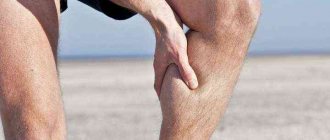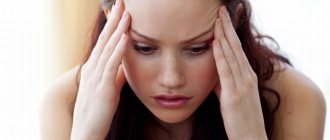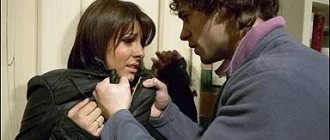05.05.2017
People experiencing dystonia often have to deal with feelings of anxiety and fear.
Such feelings provoke a surge in adrenaline levels in the body, as the body prepares to repel the approaching danger, to escape from the threat.
In this state, muscle tone increases significantly; not only skeletal muscles, but also the fibers of internal organs and blood vessels are subject to tension. A similar state can easily be provoked by taking a lot of strong coffee or energy drinks.
Constant tension is not a natural state for the body; it also needs rest in order to restore wasted energy. Just as after physical labor, fatigue is relieved by relaxation, and after emotional stress, the body needs to relax, so a person feels weak during VSD, even without experiencing any physical activity before.
The reason for this reaction is that with dystonia, the body is constantly under the influence of fear hormones and in tension. The muscles are in static tension.
You can feel what such tension is like if you stretch your arm forward and try to hold it there for 5-10 minutes. It seems that the hand did not do any work, but the muscles get tired, hurt and require rest.
The same effect with muscles is observed in vegetative-vascular dystonia. Weakness is felt especially strongly after a panic attack. The longer the attack lasted and the brighter the manifestations, the stronger the fatigue and desire to rest will manifest itself. Fear hormones, the surge of which was in the body, must collapse and leave the body, and this takes time, only then their action will stop keeping the body in good shape.
How to overcome weakness with VSD
If the provocateurs of sudden weakness in dystonia are fear hormones in the blood, then it is logical to assume that in order to get rid of drowsiness and weakness, you need to reduce the amount of such hormones in the body. Medicine knows two effective ways to help overcome this condition.
The first way to eliminate attacks of weakness is to take psychotropic pills that have an anxiolytic effect. In other words, these are medications that can remove fear and prevent the production of fear hormones. Thanks to such drugs, the body ceases to experience constant static tension, as a result there is no weakness, and performance increases significantly.
You need to take the medicine not once, but constantly over a long period. It is necessary to achieve such an effect that the body gets used to considering a state without manifestations of a panic attack as normal, then anxiety and a feeling of fear will no longer bother you. A similar effect can be achieved without pills if you come to terms with your fears, including the fear of death, and stop being afraid of them.
The second way to eliminate weakness in VSD is to eliminate the fear hormones that have entered the blood. For example, using charging. You need to overpower yourself, if necessary - force yourself to get out of bed during the onset of fatigue, give your body a load.
There is no need to go to the gym - just running or walking. The load should not be excessive - there is no need to cause any increase in heart rate or excessive sweating, the goal is different. Overload can have the opposite effect - provoke even more hormones in the blood, which will end in complete impotence or a new attack of panic attack after the end of the exercise.
Therefore, the load should be calm, measured, aimed at blood circulation and normalization of the nervous system.
How is diagnostics carried out?
Because dystonia is always a complex health problem, diagnosing it can be difficult. And with all these unpleasant manifestations, vegetative-vascular dystonia (VSD) is not recognized by many doctors as a separate disease. They consider this a syndrome that is accompanied by numerous unpleasant symptoms and affects several systems and organs of human life.
Sometimes doctors advise you to get enough sleep, take vitamins, hoping that your general condition will return to normal. Doctors often turn out to be fair, but it happens that VSD is delayed and then consultation with several specialists may be required: a therapist, a cardiologist, a neurologist, an endocrinologist, and even a psychotherapist.
For a correct diagnosis and subsequent effective fight against muscle weakness, for VSD it is better to undergo:
- Magnetic resonance imaging.
- Rheovasography (study of blood circulation in the upper and lower extremities of a person).
- Rheoencephalography (study of cerebral vessels).
- Echocardiography.
At the appointment, the doctor will definitely clarify whether there have been similar cases in the family, because, as already mentioned, very often the disease is hereditary.
Magnetic resonance imaging is the best way to diagnose the disease
Why does weakness occur in the legs?
Patients often complain of weakness in the legs during VSD, lack of desire to move and work, or perform the simplest movements. People tend to justify their actions, no matter what it concerns, the same with vegetative dystonia - there are a thousand suspicions about the state of their health, just not to play sports.
The person complains to the doctor, but the diagnosis does not reveal the disease, and then the specialist recommends walking more and doing exercises. But usually patients with dystonia are not satisfied with this answer; they look for another doctor who could detect a terrible disease that deprives them of strength.
Other doctors will say the same thing as the first doctor, but usually this is not a reason for the patient to start exercising. The next choice is medications. However, you need to understand that without movement in the human body, blood circulation and the production of certain substances are disrupted. For example, lactic acid, necessary for organs and the brain, is produced during the work of skeletal muscles.
Patients with dystonia need to understand that the main cause of the pathology is in their head, or more precisely, in their thoughts and reluctance to change something. That is why, when deciding to take their first walk on foot, people may feel shortness of breath and palpitations, and stop. This is the wrong approach.
The heart is a muscle that, like others, needs protein, the synthesis of which occurs from physical stimuli. In addition, with little physical activity the heart weakens and it becomes difficult for it to circulate blood throughout the body. As a result, vasodilation, hypertension and other diseases occur. Therefore, the heart muscle, like others, needs to be trained.
Symptoms of VSD
Doctors divide vegetative-vascular dystonia into 3 types: sympathicotonic, parasympathicotonic and mixed. Depending on the manifestations of symptoms, the specialist determines the extent of the disease, as well as the location. The symptoms of VSD can be hidden, paroxysmal and constant. Classic signs of VSD:
Enter your pressure
Move the sliders
120
on
80
- arrhythmia;
- neurosis;
- pressure surges;
- heart pain;
- vegetative failures;
- breathing disorder (lack of air, lump in throat).
In 90% of people suffering from attacks of VSD, cardiac syndrome occurs: a person feels heart contractions, rhythm disturbances, chest pain, and cardiac arrest. Fatigue sets in, severe weakness in the arms and legs, physical activity is poorly tolerated. The attacks vary in time, the nature of the pain is aching, burning. Despite the manifestation of arrhythmia, studies of the functioning of the heart muscle do not confirm deviations or changes.
Types of vegetative-vascular dystonia
The hypertensive type of disease is associated with an increase in blood pressure to the upper limit of normal - 130/85−140/90 mm Hg. Art. Against this background, headaches, palpitations, and constant weakness occur, but the likelihood of a crisis developing is minimal. With the hypotonic type, apathy, fatigue, drowsiness occurs, and fainting is possible. This type affects people who are asthenic, pale, often cold, and have increased tone of the parasympathetic nervous system. The maximum blood pressure level does not exceed 100 units.
There may be an unreasonable increase or decrease in temperature, sweating, trembling, and a feeling of heat. With VSD, weather dependence occurs and the body's adaptation to stress or exercise decreases. Autonomic dysfunction manifests itself in fearfulness, irritability, apathy, or vice versa - excessive activity. Severe types of the disease are characterized by hypochondria and even suicidal tendencies.
Diagnosis and treatment
Before talking about any treatment, you need to undergo an examination and identify vascular dystonia or other diseases, since the therapy differs in each case.
It is necessary to exclude the presence of other pathologies that can cause weakness. If the diagnosis is VSD, then you need to rely not only on doctors, but also on your own to get involved in the treatment process, then the result will be excellent.
To get rid of the influence of dystonia, you need to gather your willpower and include physical activity in your daily routine. It is important that the activities are enjoyable. This could be swimming, roller skating, walking long distances with headphones on to the sounds of your favorite tracks.
Those who have not been physically active for a long time should start with walking. At first, 10 minutes is enough, every day the walking time increases, then the pace and distance. It is better to organize your walking marathon every other day so that the body has time to restore strength and fill up with energy.
Recommendations for patients with dystonia
In addition to physical activity, if you have weakness due to dystonia, you can follow the recommendations of experienced neurologists listed below:
- Change your diet and adjust it towards a healthy diet. You need to give up sausages, juices and lemonades, and instead eat fresh vegetables and fruits. For breakfast you should eat omelettes, cottage cheese, yoghurts, and cereal porridges. Instead of 3 meals a day, you can try a more effective scheme - often, but little by little. This way the digestive system will work more efficiently, and the body will absorb nutrients easily and quickly.
- Find motivation. It is important to decide what is good about being healthy. Not for someone, but for yourself. It is important to understand why you need to live and why you need to monitor your health, and constantly return to this thought in order to support yourself on this difficult path.
- Watch less TV. Watching TV shows is addictive; hours fly by on the couch in front of the screen. It is better to replace the TV with books, it is healthier and not so harmful to the nervous system. Reading will help you take your mind off panic attacks. You don't have to wait for them all the time and they won't come.
It is important to consult an experienced neurologist from the very beginning. The specialist will conduct a diagnosis, rule out the presence of pathologies, and if VSD is diagnosed, he will prescribe the correct treatment regimen, tell you how to deal with weakness and overcome the state of fear.
The doctor’s recommendations will include dietary adjustments, medications and physical activity. In tandem with a good specialist, you can improve the quality of your life, stop suffering and waste such precious time.
Chills with high blood pressure: why does it shake with hypertension?
With high blood pressure, the patient constantly complains of a rapid heartbeat, a feeling of burning heat, noise and ringing in the ears. As the symptoms increase, the patient begins to suffer from chills and shakes, as if he had a high temperature.
When hypertension occurs, a spasm occurs in the muscles of the skin and blood vessels. A patient with high blood pressure suddenly becomes very cold, trembling spreads throughout the body. First of all, the masticatory muscles of the facial joint are affected, and then the whole body shakes.
In an absolutely healthy person, chills occur when exposed to cold, which is a normal natural reaction of the body. If a person is easily excitable, trembling in the body will be the result of severe stress and fear.
Why does trembling occur?
Chills are a clear symptom of serious problems in the human body. It is always accompanied by weakness, malaise, and a constant desire to rest and lie down. There are several reasons for this condition, the most common of which should be noted:
- hypothermia;
- infection;
- stress;
- increased blood pressure;
- vegetative-vascular dystonia.
Moreover, the last 3 points are closely related to each other. Under stress or nervous tension, blood pressure can rapidly increase even without a history of cardiovascular disease. To normalize the condition, it is useful to drink several tablets of Valerian extract, a sour decoction of berries, tea with lemon or herbal tea. Infusions of blackberries and black currants will help cope with chills perfectly.
The manifestation of chills often occurs in people with vegetative-vascular dystonia, which is explained by a lack of heat due to circulatory disorders. Such patients almost always have cold hands and feet, which is caused by a violation of natural vascular tone.
A contrast shower, a hot bath or a trip to the sauna will help get rid of chills. Gradual systematic hardening of the body will be no less effective. To quickly remove toxic substances that are formed during stress, as well as to get rid of chills, it is recommended to use a decoction of lingonberry leaves.
In people who suffer from sudden changes in blood pressure, chills may be a symptom of the onset of a hypertensive crisis. Wherein:
- the condition of blood vessels changes;
- blood circulation is impaired.
As soon as the pressure decreases, the person stops shaking.
In some cases, chills occur with Rhine disease, when vascular spasms occur. In this situation, a Botox injection will help get rid of the symptom. You will definitely need to give up smoking and alcoholic beverages.
In approximately 10% of cases, chills against the background of high blood pressure become a sign of another serious disease, for example, damage to the kidneys or thyroid gland.
Three degrees of hypertension
on
High blood pressure is characteristic of hypertension. Pathology is usually divided into 3 degrees, depending on the tonometer readings:
- first degree – 140-159/90-99;
- second degree – 160-179/100-109;
- third degree – over 180/110 mm. rt. Art.
At the first stage, hypertension does not manifest itself in any way, except for periodic headaches, constant overwork and excessive irritability.
With so-called mild hypertension, chills and internal heat practically do not overcome the patient. These symptoms occur only in the second and third stages of the disease, when the pressure exceeds 160/100 mm. rt. Art. However, it often happens that the patient begins to shake even at lower blood pressure.
The main danger of hypertension is that, if uncontrolled, the pressure increases more and more. The patient runs the risk of ruptured blood vessels, cerebral hemorrhage, and stroke.
When there is no adequate treatment, high blood pressure negatively affects the entire body:
- atherosclerosis of blood vessels and aorta develops rapidly;
- there is a pronounced formation of plaques on the walls of the arteries;
- The lumen of blood vessels decreases, their compaction occurs;
- There is a violation of microcirculation in vital organs.
The response to increased resistance of hard vessels is accelerated work of the heart muscle, left ventricular hypertrophy, impaired diastolic relaxation of the myocardium, circulatory disorders, and arrhythmia. If one of the arteries becomes completely blocked, the heart will stop receiving blood and a myocardial infarction will develop.
The most common cause of the development of the disease is narrowing of arterioles - small branches of arteries. The heart is forced to pump blood with maximum effort to cope with the situation and overcome the constriction.
In about a third of hypertensive patients, chills will be a sign of a vegetative crisis, which is also called panic attacks. The reason for this condition:
- activation of the stimulating department of the autonomic nervous system;
- active production of adrenaline by the adrenal glands.
Other signs will be: increased headaches, pounding in the temples, tingling in the heart. With high blood pressure, the patient lacks air, legs and arms become numb, the urge to urinate becomes more frequent, and sometimes the body temperature may rise slightly.
This condition does not pose a direct threat to life, but the patient is haunted by indescribable excitement and panic.











